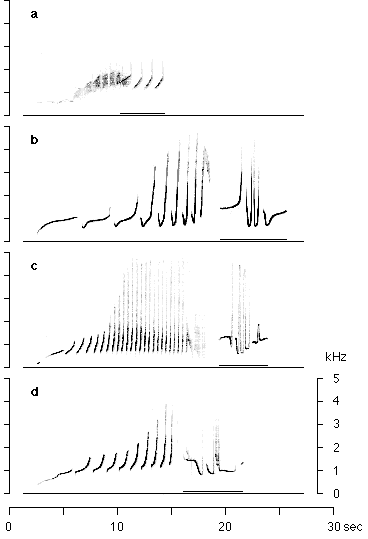This section was published as:
Geissmann, T., 1997: New sounds from the crested gibbons (Hylobates concolor group): First results of a systematic revision. Verhandlungen der Deutschen Zoologischen Gesellschaft: Kurzpublikationen - Short Communications. 90. Jahresversammlung 1997 in Mainz (Zissler, D.; ed.), p. 170, Gustav Fischer, Stuttgart.
A printable pdf-file of this paper can be downloaded here.
![]()
The crested gibbons have traditionally been regarded as consisting of a single species, Hylobates concolor, containing 6 subspecies (concolor, hainanus, lu, leucogenys, siki, gabriellae). More recent studies suggested that this group should be split into two species, H. concolor and H. leucogenys, with concolor, hainanus and lu being subspecies of the former. Some even suggested recognition of a third species, H. gabriellae, with some debate as to whether siki is a subspecies of H. leucogenys or of H. gabriellae. Also more recently, two new black gibbon subspecies have been described from the Chinese Province of Yunnan (H. c. furvogaster and H. c. jingdongensis).
The present study describes and compares crested gibbon vocalizations and fur characteristics. Tape-recordings were carried out in a large number of European, Asian and American zoos and in the wild in southern Vietnam and in southwestern China, including Yunnan Province and Hainan Island. In addition, virtually all known wild-shot museum specimens world-wide were examined.
First results based on museum skins and vocalizations of captive gibbons clearly support the recognition of the species H. concolor, H. leucogenys and H. gabriellae, with siki being more closely related to H. leucogenys than to H. gabriellae. Tape-recorded songs of wild populations, however, suggest the existence of an intermediate population between siki and gabriellae. No clear vocal or color differences were found among Chinese populations of H. c. concolor, H. c. jingdongensis and H. c. furvogaster, making the recognition of the latter two taxa questionable.
Two unnamed forms of crested gibbon were identified based on Zoo and Museum specimens from northeastern Vietnam. At least one of them, tape-recorded at the Tierpark Berlin, produces a radically distinct song, and the same type of song was found in the population from Hainan island (Fig. 1a). Although these three populations have been previously attributed to H. concolor, they should be recognized as three subspecies of a distinct species, tentatively identified here as ylobates cf. nasutus.
Chances that the species will survive the next 50 years are very low. First, it is unclear whether the two mainland subspecies still survive in the wild. The Berlin female was caught in 1962, and the most recently shot Museum specimen stems from 1965. No recent sightings of gibbons have been reported from northeastern Vietnam. Second, the author's own survey on Hainan revealed that the island form is probably down to less than 20 individuals, suggesting that this may be one of the rarest primate species worldwide.

Great call phrases, uttered as a duett by mated pairs, of four species of crested gibbons. Male contributions are underlined. a. H. cf. nasutus hainanus (Bawangling, Hainan), b. H. concolor (Ailao mountains, Yunnan Prov.), c. H. leucogenys leucogenys (Paris, Ménagerie), d. H. gabriellae (Mulhouse Zoo).
![]()